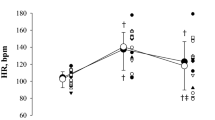Abstract
Regional cerebral blood flow was measured with the 133-Xenon inhalation method in seven healthy subjects with orthostatic hypotension not due to autonomic failure (i.e. non-neurogenic clinical disorder). Measurements were performed during supine rest and during head-up tilt (70°). All subjects had a consistent drop in systolic blood pressure and the typical symptomatology of orthostatic hypotension. The results showed lower mean hemispheric blood flow during head-up tilt than during supine rest. In addition, a consistent and significant redistribution of the regional flow values was seen, with a reduction in frontal and an increase in postcentral areas. The frontal flow decrease during tilt was more marked than in subjects without orthostatic hypotension and was not related to variations in the level of pco2 or to respiration. In contrast to the clinical symptoms of orthostatic hypotension (dizziness, nausea, visual disturbances, and in some cases syncope), the cortical blood flow reduction was, however, relatively moderate.
Similar content being viewed by others
References
Mader SL. Orthostatic hypotension.Med Clin North Am 1989;73: 1337–1349.
Bannister R, Mathias CJ. Introduction and classification. In: Bannister R, Mathias CJ, eds.Autonomic failure. A textbook of clinical disorders of the autonomic nervous system, third edition. Oxford: Oxford University Press, 1992: 1–12.
Warkentin S,et al. Redistribution of blood flow in the cerebral cortex of normal subjects during head-up postural change.Clin Auton Res 1992;2: 119–124.
Obrist WD, Thompson HK, Wang HS, Wilkinson WE. Regional cerebral blood flow estimated by 133-xenon inhalation.Stroke 1975;6: 245–256.
Risberg J, Ali Z, Wilson EM, Wills EL, Halsey JH. Regional cerebral blood flow by 133-xenon inhalation.Stroke 1975;6: 142–148.
Risberg J. Regional cerebral blood flow measurements by 133-xenon inhalation: methodology and applications in neuropsychology and psychiatry.Brain Lang 1980;9: 9–34.
Mathias CJ, Bannister R. Investigation of autonomic disorders. In: Bannister R, Mathias CJ, eds.Autonomic failure. A textbook of clinical disorders of the autonomic nervous system, third edition. Oxford: Oxford University Press, 1992: 489–509.
Maximilian VA, Prohovnik I, Risberg J. Cerebral hemodynamic response to mental activation in normo and hypercapnia.Stroke 1980;11: 342–347.
Ingvar DH. Hyperfrontal distribution of the cerebral grey matter flow in resting wakefulness: on the functional anatomy of the conscious state.Acta Neurol Scand 1979;60: 12–25.
Brooks DJ, Redmond S, Mathias CJ, Bannister R, Symon L. The effect of orthostatic hypotension on cerebral blood flow in middle cerebral artery velocity in autonomic failure, with observations on the action of ephedrine.J Neurol Neurosurg Psychiatry 1989;52: 962–966.
Edvinsson L, Mackenzie ET, McCulloch J.Cerebral blood flow and metabolism. New York: Raven Press, 1993: 553–580.
Johanson A, Smith G, Risberg J, Silfverskiöld P, Tucker D. Left orbital frontal activation in pathological anxiety.Anxiety, Stress, and Coping 1992;5: 313–328.
Wieling W. Standing, orthostatic stress, and autonomic failure. In: Bannister R, Mathias CJ, eds.Autonomic failure. A textbook of clinical disorders of the autonomic nervous system, third edition. Oxford: Oxford University Press, 1992: 219–311.
Blomqvist CG, Stone HL. Cardiovascular adjustment to gravitational stress. In: Shepherd JT, Abboud FM, eds.Handbook of physiology, Volume3 1983: 1025–1063.
Shepherd JT, Mancia G. Reflex control of the human cardiovascular system.Rev Physiol Pharmacol 1986;105: 1–99.
Author information
Authors and Affiliations
Rights and permissions
About this article
Cite this article
Passant, U., Warkentin, S., Minthon, L. et al. Cortical blood flow during head-up postural change in subjects with orthostatic hypotension. Clinical Autonomic Research 3, 311–318 (1993). https://doi.org/10.1007/BF01827332
Received:
Accepted:
Issue Date:
DOI: https://doi.org/10.1007/BF01827332




